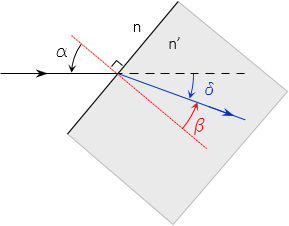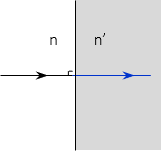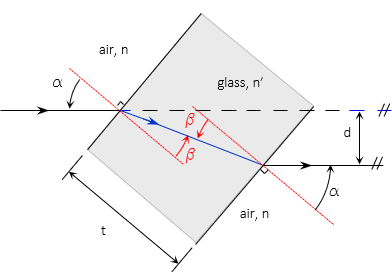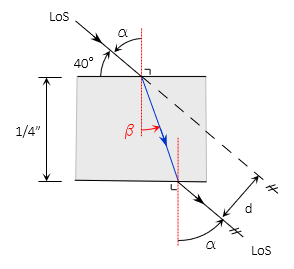2. Refraction - Snell's Law
Snell's Law, Equation H-1, describes the amount a light ray deflects when it crosses the boundary between two dissimilar media, Figure H-1.
| Equation H-1 | |
|
n: refraction index of first medium |
|
 |
| Figure H-1 Snell's Law |
Incident and refracted angles are referenced to the surface normal: the line perpendicular to the interface (red line in Figure H-2) at the light ray intersection.
The light ray does not refract if it intersects the interface at a right angle. Figure H-2.
 |
| Figure H-2 No Refraction |
Refraction indicies are related to media densities: a denser medium will slow the speed of light. Where density changes, light is bent. Line of Sight refraction was discussed in II. Errors Chapter E. Systematic Errors Sec 3. Curvature and Refraction. The difference is that the LoS passes through an atmosphere of changing density so it is continually bent. Snell's law deals with two different but homogeneous media. Once refracted at the interface, the light ray continues in a straight line until it encounters another interface.
There can be media which do in fact have varying density and bend the light ray internally. These aren't typically used in surveying applications, so we will limit discussion to homogeneous media.
Figure H-3 shows a flat glass plate with air on both sides. A light ray intersecting the panel at an angle is refracted toward the normal in the glass, then away from the normal when it re-enters the air - it only changes direction at the interfaces. The refraction at each interface is the same since there are only two different media.
 |
| Figure H-3 Flat Glass Plate |
The emergent ray on the right is parallel with the initial ray on the left but displaced. Displacement (d) depends on the initial angle of incidence, plate thickness (t), and refractive indicies, Equation H-2.
 |
Equation H-2 |
Example
A surveyor's horizontal line of sight passes through a vertical plate glass window. How much is the LoS offset if it intersects the window at an angle of 40° and the glass is 1/4" thick with a 1.50 refractive index? Use 1.00 for the refractive index of air.
Sketch
Because the LoS is horizontal and the window vertical, the offset is horizontal. Looking down from above the displaced LoS looks like this:

Compute the incident angle
![]()
Compute refractive angle

And finally displacement, converted to feet:
